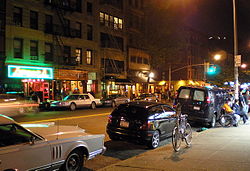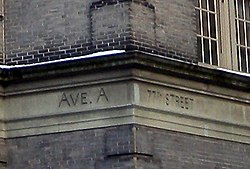Avenue A (Manhattan)


The Avenue A is a street in the south-east of New York City's borough Manhattan .
Location and course
Of the avenues designated with letters, avenue A in the East Village is the westernmost and at the same time the western border of Tompkins Square Park and the Alphabet City district , which owes its name to avenues A, B and C.
Avenue A runs from Houston Street in the south to 14th Street in the north, where it ends in a loop in Stuyvesant Town ( 14th Street Loop ) that connects Avenue A and Avenue B. South of Houston Street, Avenue A continues as Essex Street .
history
Due to the Commissioners' plan of 1811 , which regulated the street grid in Manhattan north of 14th Street, the avenues were usually numbered consecutively - starting with First Avenue on the East Side and ending with Twelfth Avenue on the West Side . East of First Avenue offered the Commissioners' Plan identifies four additional lettered avenues "numbered" - from Avenue A west to Avenue D .
While First Avenue is usually the easternmost avenue of Manhattan, there are still various interrupted parts of Avenue A north of Alphabet City: A short section of Avenue A was built over in 1947 by Stuyvesant Town – Peter Cooper Village . To the north of this it is now called Asser Levy Place . Today's Sutton Place was also once called Avenue A to Effingham B. Sutton built a series of houses - so-called brownstones - between 57th Street and 58th Street in 1875 , from which the street section finally got its name (first documented in an edition of The New York Times from 1883). The New York City Council approved a motion to rename the blocks between 57th Street and 60th Street from "Avenue A" to "Sutton Place". In 1928, the northernmost block of Sutton Place between 59th Street and 60th Street and the entire north section of Avenue A to 92nd Street were renamed York Avenue - in honor of US Army Sergeant Alvin York , who received the Medal of Honor for his service received in the Meuse-Argonne offensive during World War I on October 8, 1918.
The northernmost portion of Avenue A extends between 114th Street and 120th Street in East Harlem and was renamed Pleasant Avenue in 1879 .
Local transport
The M14A bus runs through the entire Avenue A.
Individual evidence
- ↑ REMARKS OF THE COMMISSIONERS FOR LAYING OUT STREETS AND ROADS IN THE CITY OF NEW YORK, UNDER THE ACT OF APRIL 3, 1807 , retrieved on May 2, 2007: “The avenues east of number one are designated A, B, C and D. . " -" The avenues to the eastward of number one are marked A, B, C, and D. "
- ↑ a b De-Classified 4-A , Forgotten NY, accessed January 1, 2008.
- ↑ Senft, Bret: “If You're Thinking of Living In / Sutton Place; A Riverside Enclave for the well-to-do " , The New York Times , June 12, 1994, accessed 27 December 2007
- ^ A b Gray, Christopher: “Streetscapes / Sutton Place, Sutton Place South and One Sutton Place North; A Prestigious Enclave With a name in Question " , The New York Times , September 21 2003, accessed on 27 December of 2007.
- ↑ Pollak Michael: "FYI" , The New York Times , August 7, 2005 accessed October 16, 2007: "In 1928, the Sutton Place from 59th to 60th Street and Avenue A north of 60th Street in York Avenue was renamed in honor of Sgt. Alvin C. York (1887-1964), a World War I hero from Tennessee and recipient of the Medal of Honor. " -" In 1928, Sutton Place from 59th to 60th Street, and Avenue A north of 60th, were renamed York Avenue in honor of Sgt. Alvin C. York (1887-1964), a World War I hero from Tennessee and a recipient of the Medal of Honor. "

